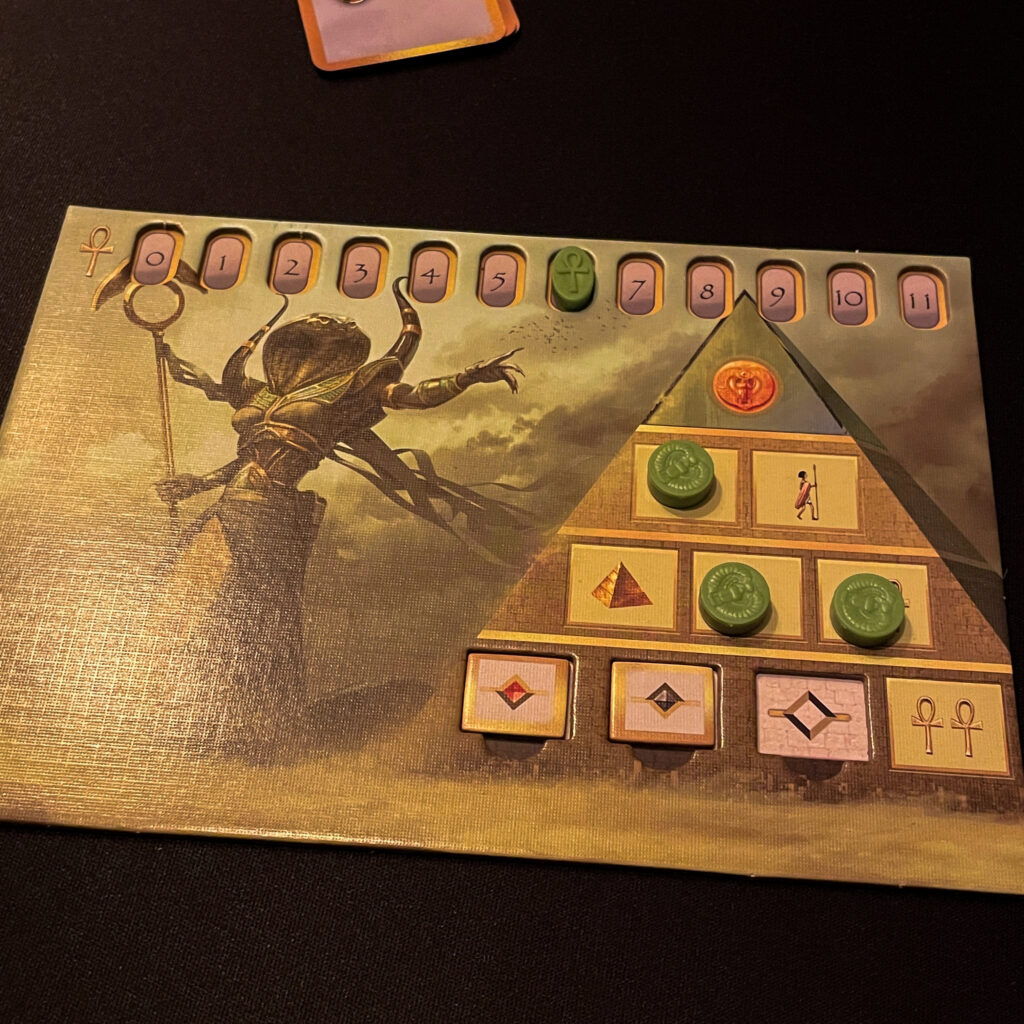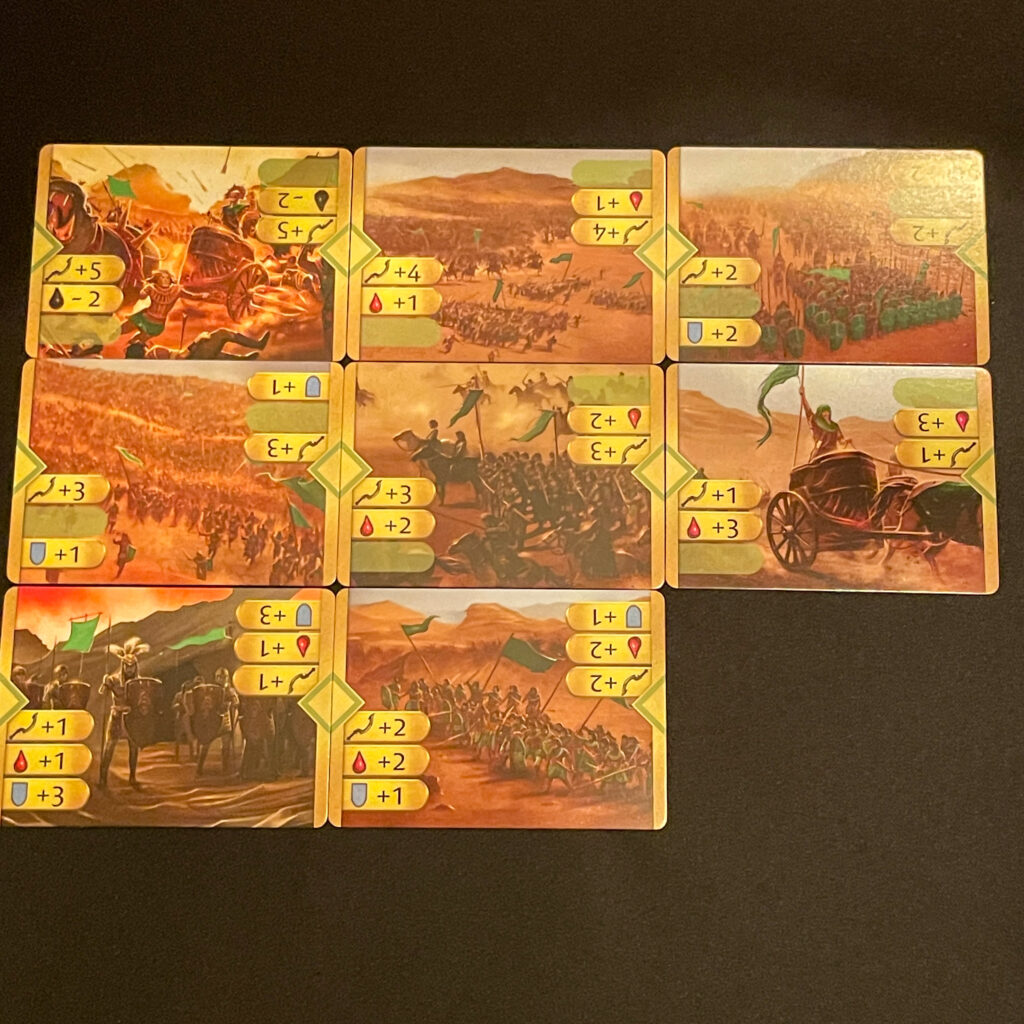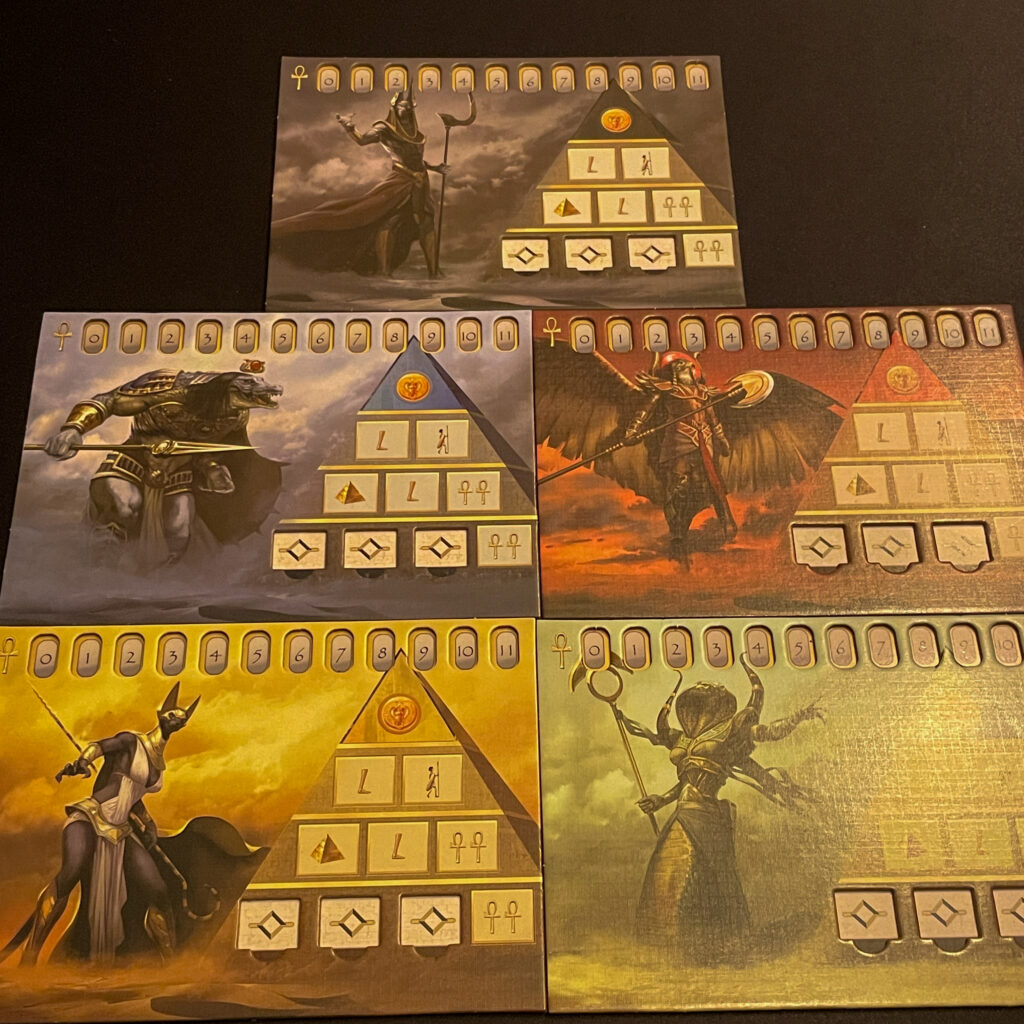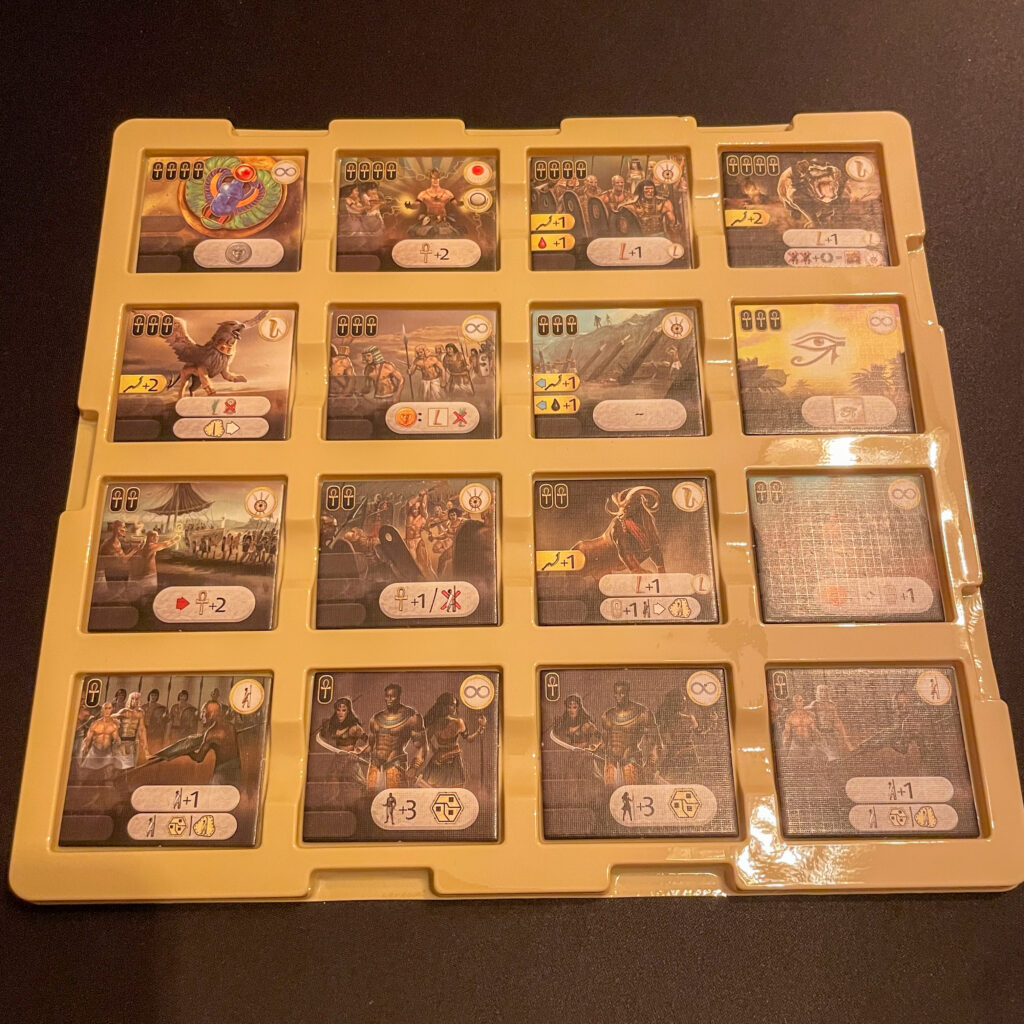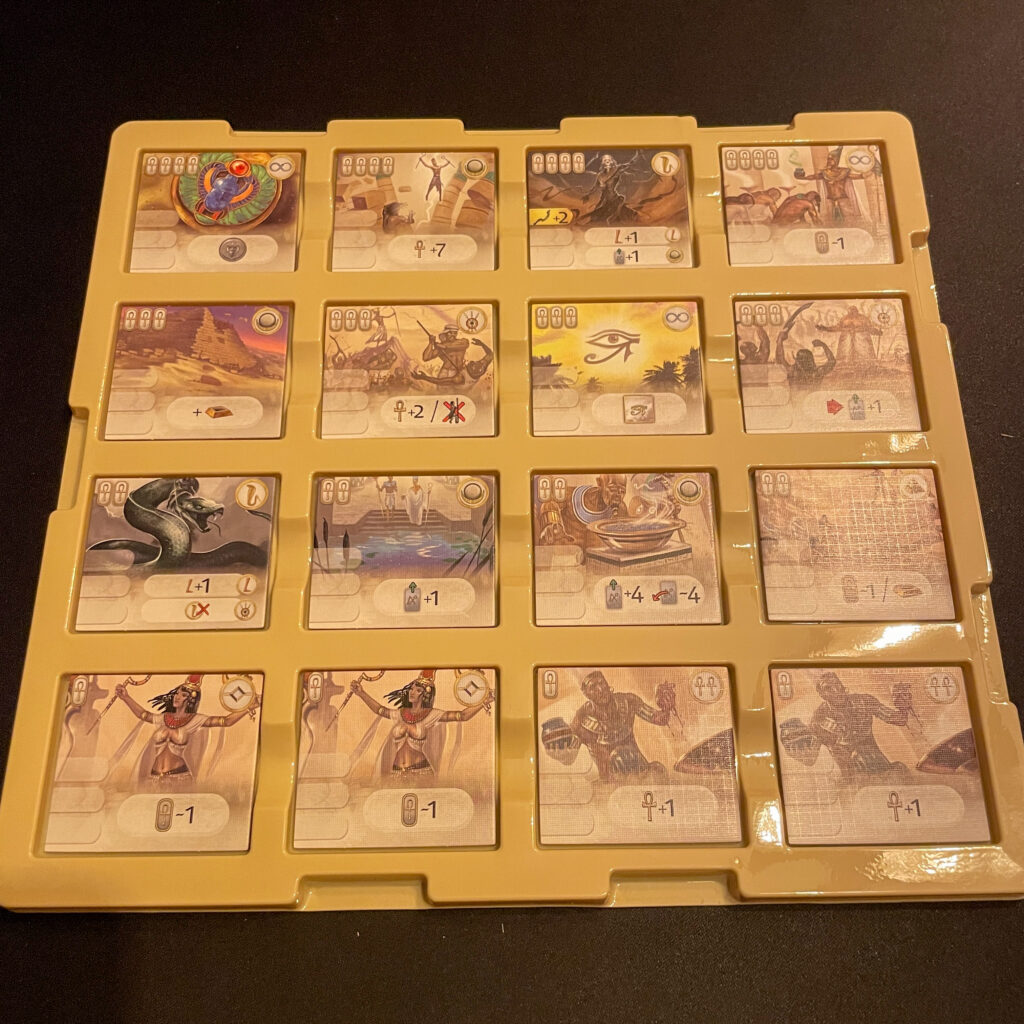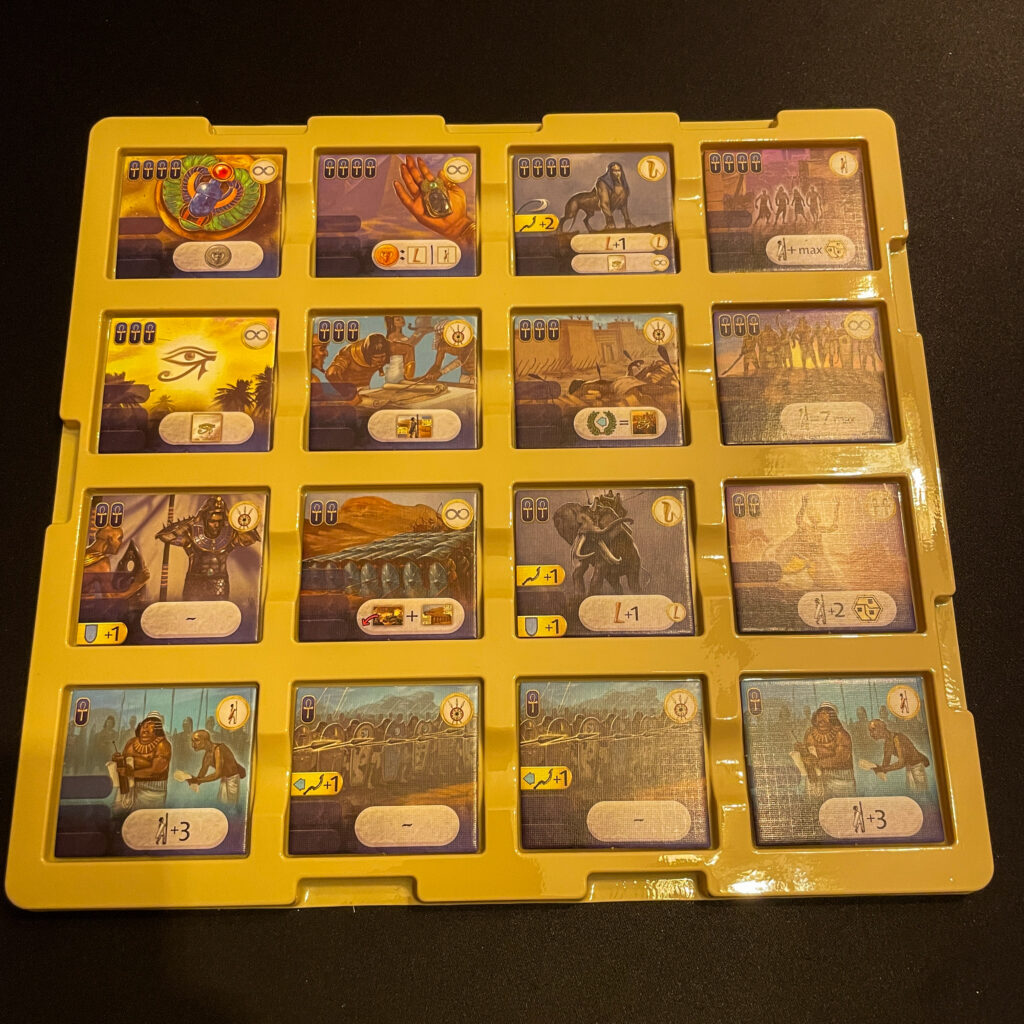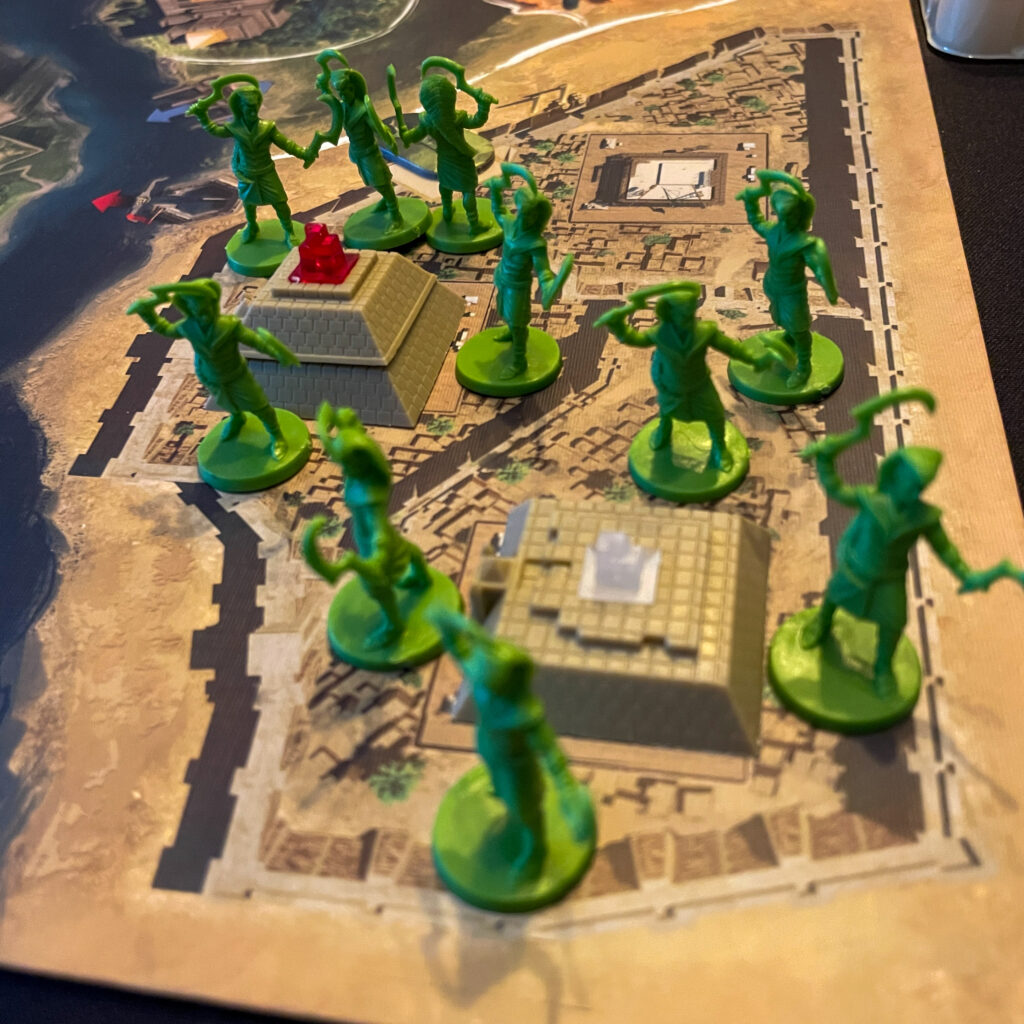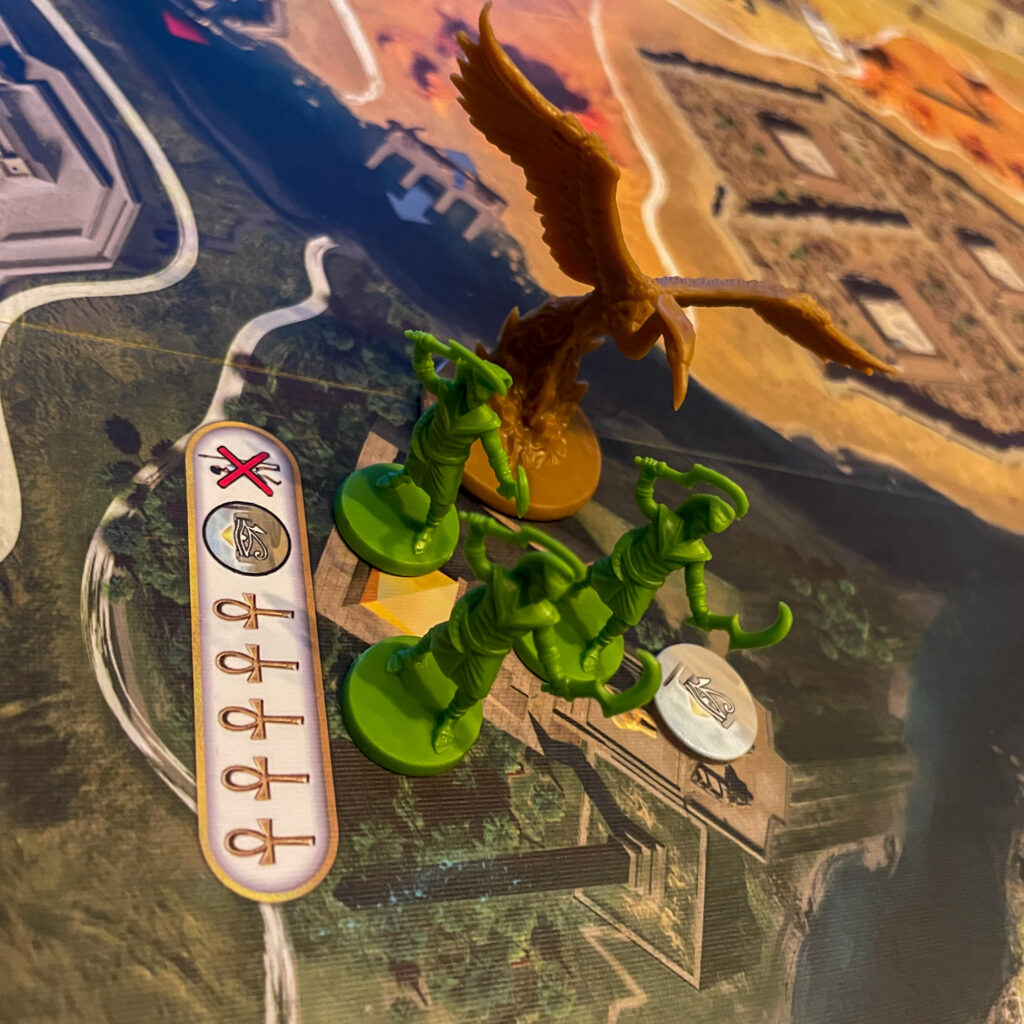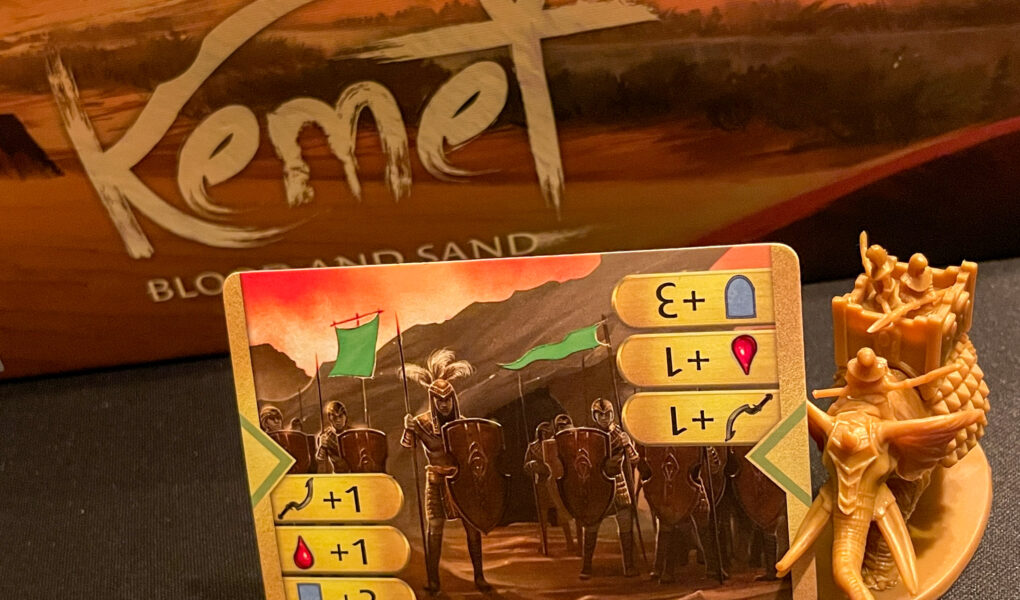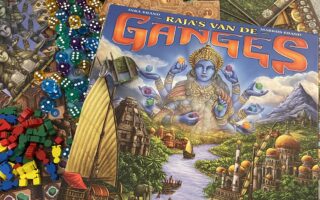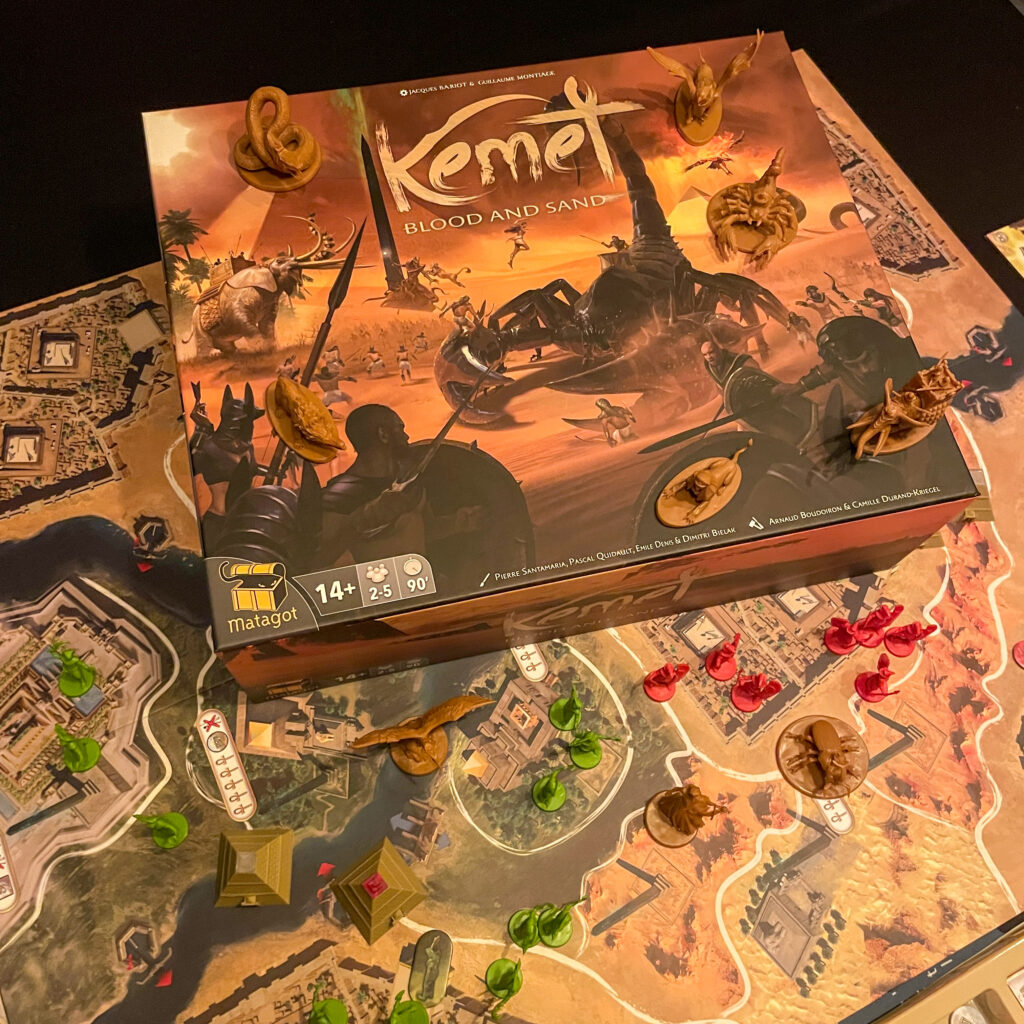
Summary
A game for 2 – 5 players
Playing time is around 90 – 180 minutes
Publisher is Matagot
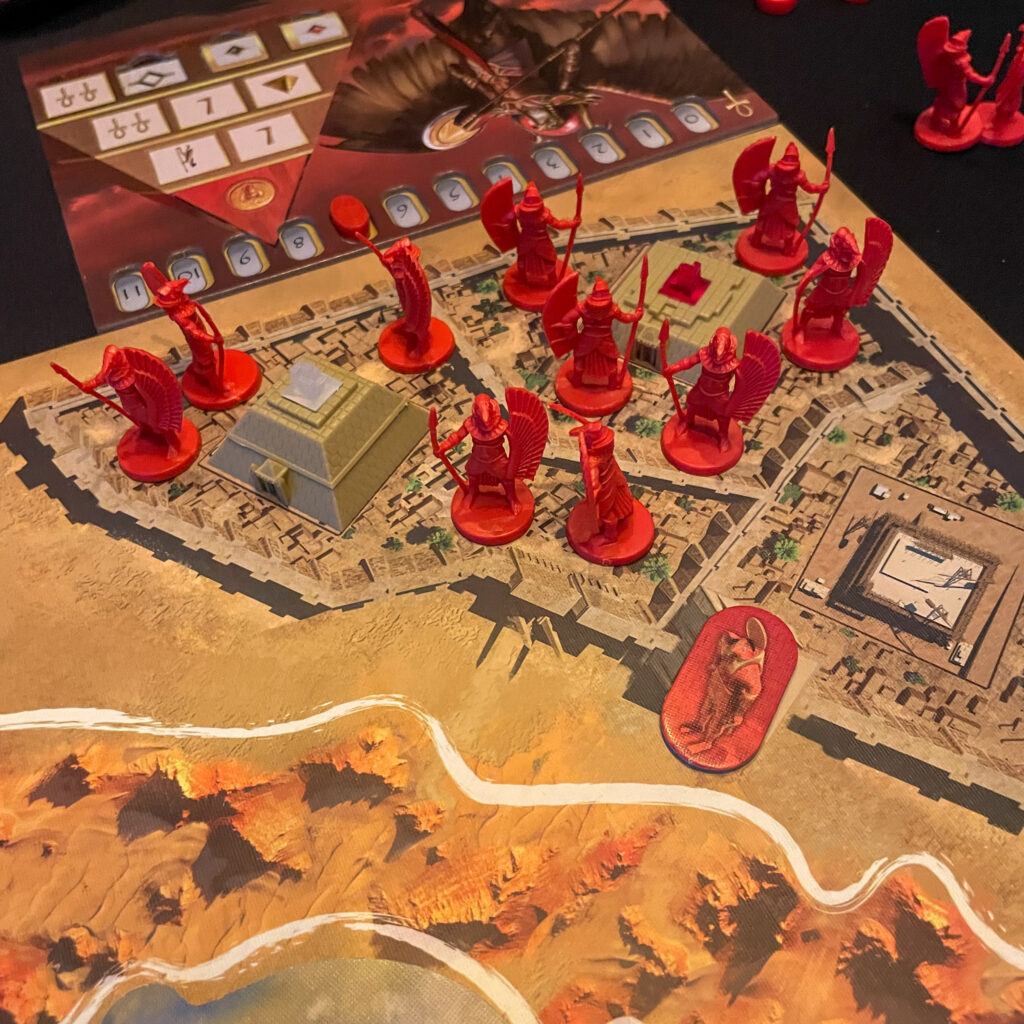
Introduction
Immerse yourself in a more realistic Ancient Egypt. Here, the gods are powerful masters of both the desert and the Nile Delta. They challenge each other in violent battles and show no mercy. Get ready to become an Egyptian god, open the gates of your city, and let your troops sing the song of war to please you and claim your dominance as the master of Ancient Egypt.
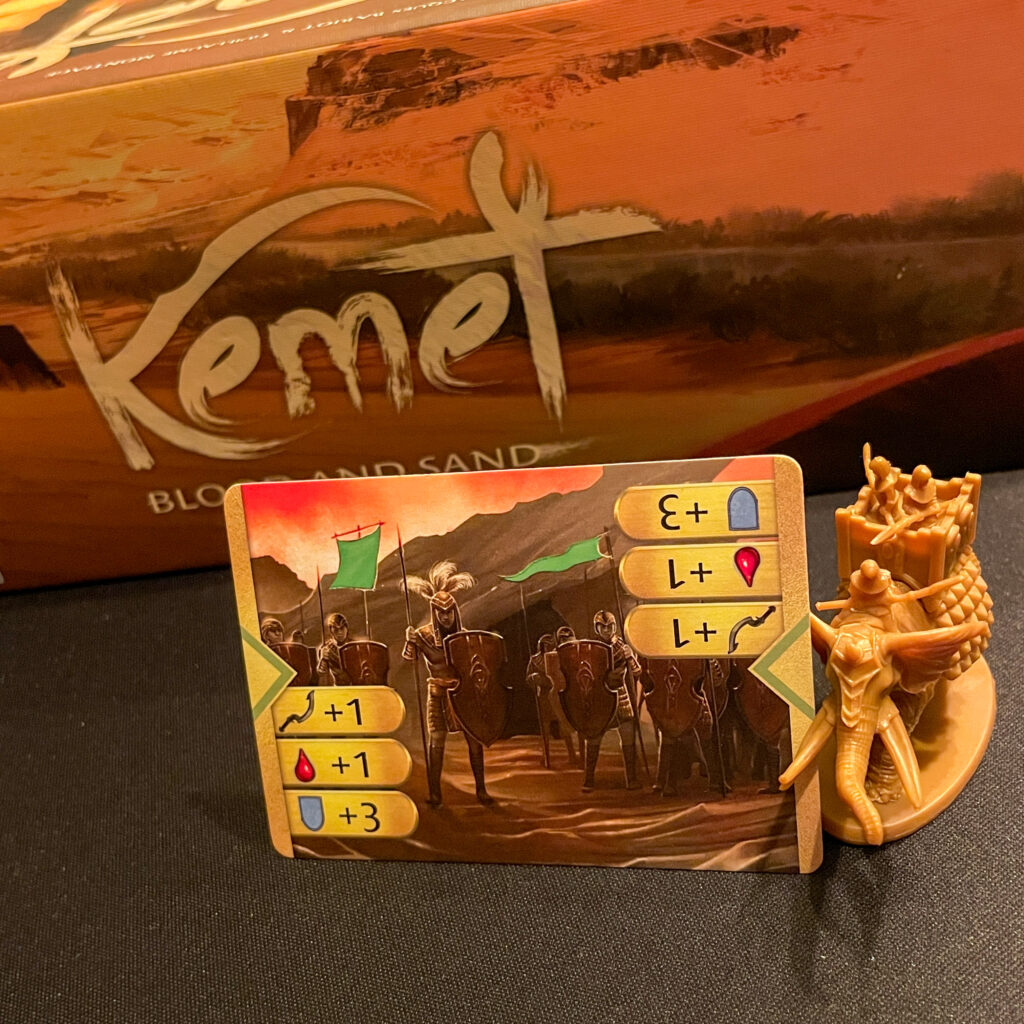
Let’s get it on the table
KEMET: Blood and Sand
Summary A game for 2 – 5 players Playing time is 90 – 180 minutes Publisher is Matagot
Introduction
Immerse yourself in a more realistic Ancient Egypt. Here, the gods are powerful masters of both the desert and the Nile Delta. They challenge each other in violent battles and show no mercy. Get ready to become an Egyptian god, open the gates of your city, and let your troops sing the song of war to please you and claim your dominance as the master of Ancient Egypt.
Setting up the game
Place the main board in the center of the table. Then apply the correct play configuration related to the player count.
Randomly choose a color for the power tiles. The quantity of colors that can be used is also related to the player count.
The chosen power tile can then be placed near the main board and within reach of all players.
Check the power tile that has the Creature symbol and place the corresponding creature on it.
Place the special battle cards on top of the board.
Place the Temple VP tokens on the dedicated temples. Then all other tokens can be used as a general supply.
Each player takes one Diversion Divine Intervention card (DI). Also, shuffle the standard DI cards and place them beside the board.
Now each player will choose a city and their color for the game.
Once decided, the player will place their statue token.
Then the player will place the matching player board and components related to their color.
Place the prayer marker on the 7th spot and draw two DI cards. Depending on the player count, prepare the pyramids and choose the color of the tops related to the color of the power tiles that are in play. These can’t be changed, so choose them wisely with the power of the Gods 😁.
Now players can take one power tile of level one for free.
Check the turn order and place the turn order marker on the track.
Place a total of 10 troops near the pyramids. Keep in mind that 5 troops, which is called a unit, is the maximum that can be in one district.
Now everybody is ready, and let’s start this play with the Gods.
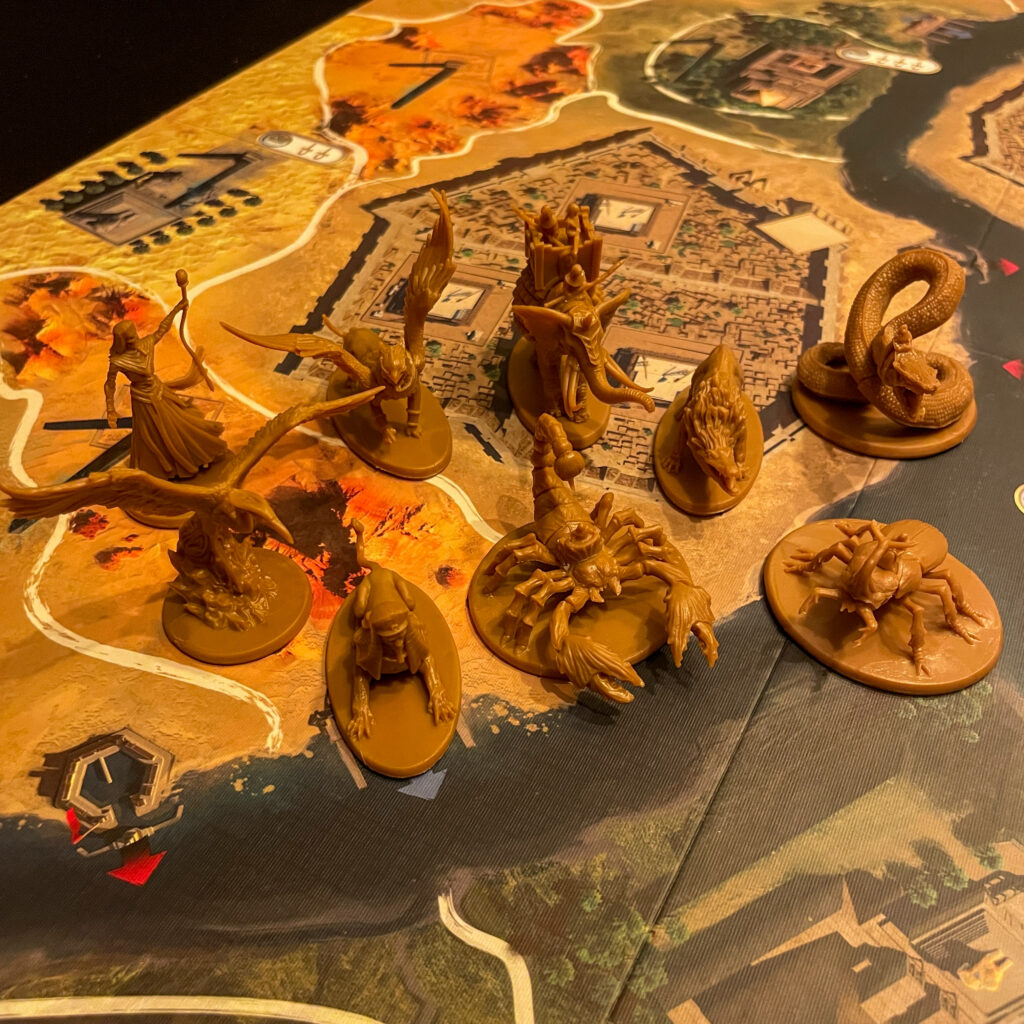
Let’s play
Each round will consist of two phases:
- Day phase: In turn order, each player becomes the active player and plays 1 Action token of their color, resolving its effect. Continue turn after turn until each player has placed all 5 of the Action tokens of their color, at which point the Day Phase is over.
- Night phase: This phase is divided into 9 steps, which are resolved in order. During these steps, Night Phase Powers activate, Divine Intervention (DI) cards are allocated, and Fame Points (FP) and Prayer Points (PP) are awarded.
Back to the Day fase, starting with the first player, they place 1 Action token of their color on an empty Action space of their Player board, and they immediately resolve the selected action’s effect.
The following actions are shown on the player boards:
-Build, add 1 or more levels to one of your Pyramids.
-Recruit, spend (PP) to add to your supply and place them in 1, 2, or 3 districts in your city.
-Acquire, acquire a Power tile related to the color and level of one of a player’s pyramids.
-Pray, gain Prayer Points
-Move, move 1 of your Troops. Besides this move action on land, players can also choose to teleport by spending Prayer Points or move over the Nile by using Harbors.
By the end of the Day Phase, each player must have at least 1 Action token on each of the 3 floors of the pyramid on their Player board.
After moving, when units enter a territory with units of opposite players, a battle will be triggered.
During a battle, both players will prepare their strategies by using a battle card from their personal decks, which are filled with Divine Intervention cards. After each player is ready, it’s time to review their cards. First, it will be checked who won the battle and the Strength of each player will be summed up. This can be a combination of units, creatures from the Power Tiles, and DI cards used.
When the winner of the battle is announced, the Damage Value will be counted. This value will also be determined by the creatures used and the DI cards in play.
The most important reason to go into battle is that the attacker can acquire Permanent Victory points.
In Kemet, there are Permanent Victory Points and Temporary Victory Points.
Temporary Victory Points are awarded when players take control of a Temple or a level 4 Pyramid. However, they can be lost or won by another player when control of a Temple or Pyramid is lost.
Permanent Victory Points, gained not only by winning battles but also by acquiring specific Power tiles or during the Night Phase by controlling at least 2 Temples or the Sanctuary of All Gods, will not be lost during the game.
After the Day phase, the Night phase will be triggered and is divided into 9 steps, which are resolved in order.
- Offering – The player that controls The Sanctuary of All Gods may remove 2 Units from that Troop to gain 1 Divine VP.
- Delta Temple Control – The player that controls the Delta Temple may remove 1 Unit from that Troop to gain 5 PP.
- Temple Control – Each player that controls at least 2 Temples gains 1 Divine FP.
- Adoration – Each player gains the number of PP shown on the Temples they control, other than the Delta Temple. This gain of PP is a single effect for each player.
- Prayers – Each player gains 2 PP and may discard Veteran tokens, which are gained after a battle, to gain Prayer Points. This gain of PP is a single effect for each player.
- Divine Intervention – In turn order, each player draws 1 DI card and may discard Veteran tokens to draw 1 DI card for every 2 Veteran tokens spent this way.
- Conscription – In turn order, each player may discard Veteran tokens to add Units in Districts in their own City that they control.
- Awakening – Each player discards any remaining Veteran tokens they have and takes back their Action tokens, placing them into their supply. Any Units exceeding the Troop limit for the Troops on the board are removed.
- Destiny – Move the Order markers below their current space on the Turn Order track. Starting with the player who has the fewest VP, then in ascending VP order, each player chooses their position on the Turn Order track by placing their Order marker on an empty space.
Now it’s the start of a new Day Phase.
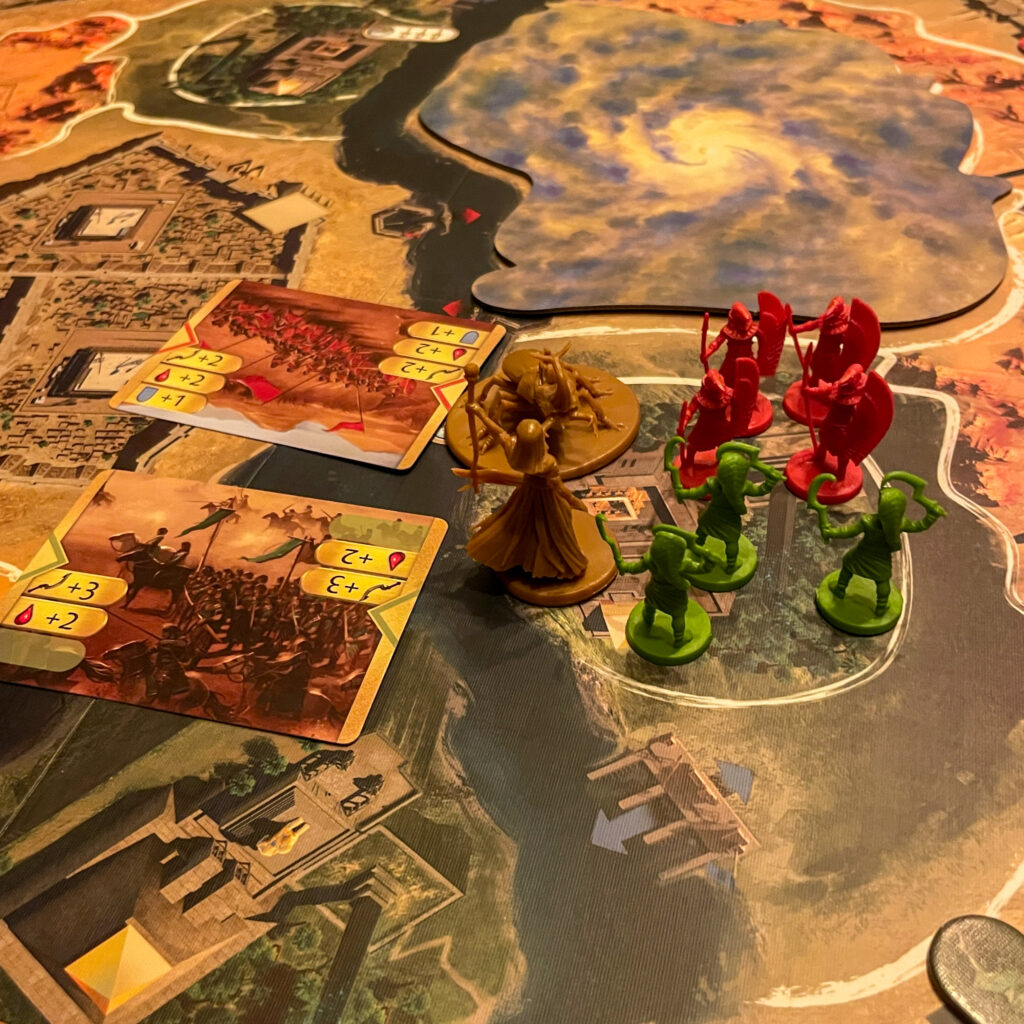
The game ends
The game ends when a player has at least 9 VP at the start of their turn in the Day Phase, before playing any Action token, and no other player has more VP than they do; they immediately win the game.
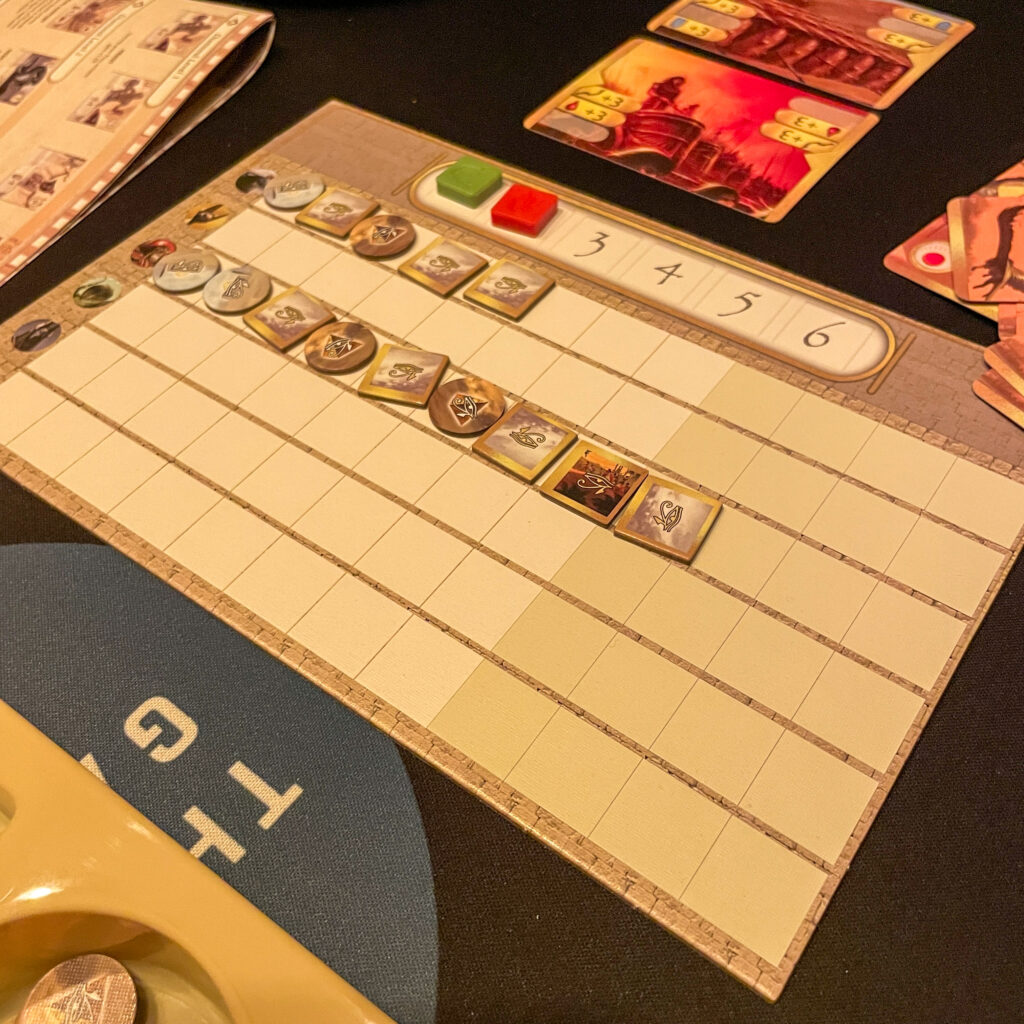
Conclusion & final score
Difficulty: 3.20/ 5
Re-playability: 7
Our score: 7 out of 10 dice
What a game! Finally, a publisher who knows how to do a rerun of an existing game, Kemet, which was released in 2012. It is a game where a good inlay is made, providing enough space to place the minis. Regarding the minis, they are also nicely done. It is easy to find which mini corresponds with its power tile. The trays where each power tile and color fit nicely are well-designed, without overdoing it. The quality is excellent, and it significantly improves the gameplay and setup. With a start like this in a review, there must be something wrong or not satisfying, right?
Yes, there is, mainly the rulebook. That could have been done much better. Not everybody played the 2012 version, so it could have been written from the perspective that new fans are getting the game on the table for the very first time. It missed some extra information or examples, which would make it a bit smoother.
Is it a mid-heavy game? No, not really. The goal is simple and relatively straightforward to reach the top of the temple.
Interaction is something you don’t need to worry about; it happens a lot. As a two-player game, players have a bit more time to build everything until the battles begin. But with three players and up, you need to be ready.
One other small thing that creates a slight imbalance in the game is the placement of the Temples. Some players can reach them more easily without the need for Teleportation, which could affect the speed of gaining Victory points.
Nevertheless, Kemet: Blood and Sand will provide many enjoyable hours filled with joy, frustration, and victories. 😁
Thanks to Matagot for this review copy and the opportunity to write about it.
